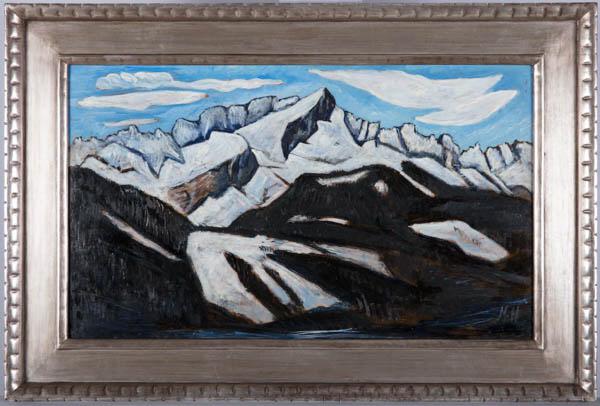Marsden Hartley the Transcendentalist

Influenced by literary antecedents like Henry Thoreau, Walt Whitman, and Ralph Waldo Emerson, Marsden Hartley documented his peripatetic lifestyle through his modernist paintings, using symbolism scavenged throughout his travels to explore the spiritual significance of place and the quotidien. Though he declared himself “the painter from Maine,” Hartley spent significant amounts of time living outside the US, these experiences exposing him to unfamiliar landscapes, and to a wider pool of avante-garde activity. Hartley traveled constantly for the two decades following WWI, a spatial restlessness that pervades his work: “Few painters have been more attuned than Hartley to the spiritual importance of location as both subject matter and physical space.” Not traditionally religious, Hartley was drawn to the spiritual ideas of 19th-century American Transcendentalists, and to Eastern religions such as Buddhism and Hinduism. This spirituality pervades many of Hartley’s paintings — his vibrant, simplified forms acting almost as mystic symbols, encoded within the strong colors and abstraction of the image.
Born on January 4th, 1877, in Lewistown, Maine, to English immigrant parents, Marsden Hartley and his family moved to Ohio, where he studied at the Cleveland School of Art, in 1893. His career as an artist took off in 1909, when Hartley was introduced to Alfred Stieglitz, who offered him a one-man exhibition at his 291 gallery. With the financial support of Stieglitz and Arthur B. Davies, Hartley traveled to Paris and Berlin in 1912, where he encountered the work of Cézanne, Matissue, Picasso, and Kandinsky. After the 1914 death of Karl von Freyburg, a German officer with whom Hartley may have been romantically involved, devastated Hartley began his War Motif series. Through the use of war motifs, Hartley takes symbols to represent both the spiritual and physical features of his subjects, an entry into the more abstract symbolism he would later embrace. Though his early abstract style was met with resistance in the States, Hartley continued to paint his progressively more recognizable subject matter with his signature strong colors, sharp contrasts, and ambiguous space. He is perhaps best known for his landscapes of Maine, the primitive figuration and portrait work conveying an innocent earnestness that continues to resonate with viewers.
While his role as an American modernist is uncontestable (a member of the distinguished circle of artists that includes Georgia O’Keeffe, Arthur Dove, and Charles Demuth), Hartley was deeply influenced by his time abroad, during which he traveled to Paris, Berlin, Bermuda, Santa Fe, Nova Scotia, and more. In 1933-4, Hartley painted “Alpspitze, Mittenwald Road from Gschwandtnerbauer,” one of a series of mountain “portraits” made during the nine months he spent in the Bavarian Alps of Germany, from fall 1933 to spring 1934. The painting was included in a 1944 exhibition of Hartley’s work at the Museum of Modern Art, which toured around the country, until it was likely bought by Monfort Dunn, at the Walker Art Center in Minneapolis. While serving in the army, James Taylor Dunn, Hamilton College Class of 1936, enlisted his brother, Monfort, to purchase works of art for his collection. This painting by Hartley was donated to the Emerson Gallery in 1986 by James Taylor Dunn.
Despite frequent changes in geographic location, mountains are a common subject in Hartley’s work, borne partially out of his special respect for the spacing and rhythm in traditional Chinese painters’ renderings of mountains. This painting by Hartley, pictured above, depicts Alpspitze in fading sunshine, the splotchy light of afternoon casting high-contrast, geometric shadows across the foreground of the work. The angular facets of rock are heavily outlined in strong shades of black, white, gray, and blue, lending the scene a weightiness and intensity. The geometric planes of the rock faces are reminiscent of Cézanne, who Hartley encountered while in Paris at the start of his career. Just as Whitman and Thoreau preached the power and profundity of nature, Hartley clearly extols these Transcendentalist values in this piece, and in numerous of his other works. The vivid colors and simplified, flattened forms further emphasize the straight-forward yet complete beauty extant within nature. His formal treatment of color and form lend the picture plane a two-dimensional quality — a distance and heft evocative of the mystical spiritualism Hartley attributes to nature.
Hartley played a key role in shaping American modernism in the early-20th century, using his heavy immersion in European modernism as the foundation for his own art. His idiosyncratic treatment of subject matter, color, and brushstroke differentiated him from his peers, and helped Hartley, through his Maine paintings, to cultivate his regional expression of American modernism. Just as Hartley approached nature with an air of mysticism, so must the viewer of his work. In March 2017, I saw Marsden Hartley’s Maine at the Met Breuer in New York City, a comprehensive showcase of ninety works stand as a testament to Hartley’s lifelong artistic engagement with his home state. The exhibition evoked a kind of earnestness — a frank, emotional rendering of the subjects and landscapes that shape his experience of place. Hartley’s studies of Maine reveal a kind of child-like fascination with home, giving the impression that no matter how far you travel, or how much you change, vestiges of where you grew up will always remain.
Bibliography:
- “Alpspitze, Mittenwald Road from Gschwandtnerbauer.” Alpspitze, Mittenwald Road from Gschwandtnerbauer – Works – Ruth and Elmer Wellin Museum of Art at Hamilton College, http://wellin-emuseum.hamilton.edu/objects/1583/alpspitze-mittenwald-road-from-gschwandtnerbauer?ctx=20238c3d-f04b-4b04-b133-12dd31541e91&idx=0.
- Panero, James. “Marsden Hartley & American modernism.” The New Criterion, vol 21, no. 7, 2003, pg. 49.
- Kornhauser, E., & Birkmaier, U. Marsden Hartley. New Haven: Wadsworth Atheneum Museum of Art in association with Yale University Press. 2002.